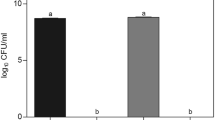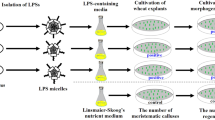Abstract
The factors suppressing division of the cells of the rhizobacterium Azospirillum brasilense and inducing their transition to a dormant state were analyzed. These included the presence of hexylresorcinol or heavy metals (Cu and Co) in the medium, oxygen stress, and transfer of the cells into the physiological saline or phosphate buffer solution. The results were used to develop a protocol for obtaining of nonculturable cells of A. brasilense Sp245, a natural symbiont of wheat. The cells lost their ability to grow on synthetic agar medium, but could revert to growth when incubated in freshly prepared liquid medium. Needle-shaped crystals differing from struvite, which has been previously reported for this strain, were found in the dormant culture of A. brasilense Sp245.
Similar content being viewed by others
References
Roszak, D.B. and Colwell, R.R., Survival strategies of bacteria in the nature environment, Microbiol. Rev., 1987, vol. 51, no. 3, pp. 365–379.
Mulyukin, A.L., Suzina, N.E., Pogorelova, A.Yu., Antonyuk, L.P., Duda, V.I., and El-Registan, G.I., Diverse morphological types of dormant cells and conditions for their formation in Azospirillum brasilense, Microbiology (Moscow), 2009, vol. 78, no. 1, pp. 33–41.
Il’chukova, A.V., Tugarova, A.V., and Antonyuk, L.P., Dormancy in rhizobacteria Azospirillum brasilense under prolonged cultivation, Vest. Saratov. Agrouniv. im. N.I. Vavilova, 2010, no. 2, pp. 7–9.
Fibach-Paldi, S., Burdman, S., and Okon, Y., Key physiological properties contributing to rhizosphere adaptation and plant growth promotion abilities of Azospirillum brasilense, FEMS Microbiol. Lett., 2012, vol. 326, no. 1, pp. 99–108.
Volkogon, V.V., Mamchur, A.E., Lemeshko, S.V., and Minyailo, V.G., Azospirilla, endophytes of cereal seeds, Mikrobiol. Zh., 1995, vol. 57, no. 1, pp. 14–19.
Tugarova, A.V., Kamnev, A.A., Antonyuk, L.P., and Gardiner, P.H.E., Azospirillum brasilense resistance to some heavy metals, in Metal Ions in Biology and Medicine, Alpoim, M.C., Morais, P.V., Santos, M.A., Cristovao, A.J., Centeno, J.A., and Collery, Ph., Eds., Paris: John Libbey Eurotext, 2006, vol. 9, pp. 242–245.
Shelud’ko, A.V., Varshalomidze, O.E., Petrova, L.P., and Katsy, E.I., Effect of genomic rearrangement on heavy metal tolerance in the plant-growth-promoting rhizobacterium Azospirillum brasilense Sp245, Folia Microbiol., 2012, vol. 57, no. 1, pp. 5–10.
Grey, B. and Steck, T.R., Concentrations of copper thought to be toxic to Escherichia coli can induce the viable but nonculturable condition, Appl. Environ. Microbiol., 2001, vol. 67, no. 11, pp. 5325–5327.
El-Registan, G.I., Mulyukin, A.L., Nikolaev, Yu.A., Suzina, N.E., Galchenko, V.F., and Duda, V.I., Adaptogenic functions of extracellular autoregulators of microorganisms, Microbiology (Moscow), vol. 75, no. 4, pp. 380–389.
Nikolaev, Y.A., Borzenkov, I.A., Kalinin, M.V., Loiko, N.G., Tarasov, A.L., Plakunov, V.K., Belyaev, S.S., Voronina, N.V., Gal’chenko, V.F., and El’-Registan, G.I., Antimicrobic features of phenolic lipids, Appl. Biochem. Microbiol., 2010, vol. 46, no. 2, pp. 159–165.
Il’chukova, A.V., Tugarova, A.V., and Antonyuk, L.P., Alkylresorcinols as growth inhibitors for the rhizobacterium Azospirillum brasilense, Vest. Saratov. Agrouniv. im. N.I. Vavilova, 2011, no. 5, pp. 12–13.
Stasiuk, M. and Kozubek, A., Biological activity of phenolic lipids, Cell Mol. Life Sci., 2010, vol. 67, no. 6, pp. 841–860.
Sadasivan, L. and Neyra, C.A., Cyst production and brown pigment formation in aging cultures of Azospirillum brasilense ATCC 29145, J. Bacteriol., 1987, vol. 169, no. 4, p. 1670–1677.
Nikolaev, Yu.A., Mulyukin, A.L., Stepanenko, I.Yu., and El’-Registan, G.I., Autoregulaton of stress response in microorganisms, Microbiology (Moscow), 2006, vol. 75, no. 4, pp. 420–426.
Kriazhevskikh, N.A., Demkina, E.V., Manucharova, N.A., Soina, V.A., Gal’chenko, V.F., and El’-Registan, G.I., Reactivation of dormant and nonculturable bacterial forms from paleosoils and subsoil permafrost, Microbiology (Moscow), 2012, vol. 81, no. 4, p. 435–445.
Kupryashina, M.A., Selivanov, N.Yu., and Nikitina, V.E., Isolation and purification of Mn-peroxidase from Azospirillum brasilense Sp245, Appl. Biochem. Microbiol., 2012, vol. 48, no. 1, pp. 17–20.
Lewis, K., Persister cells, Annu. Rev. Microbiol., 2010, vol. 64, pp. 357–372.
Pogorelova, A.Yu., Mulyukin, A.L., Antonyuk, L.P., Galchenko, V.F., and El’-Registan, G.I., Phenotypic variability in Azospirillum brasilense strains Sp7 and Sp245: association with dormancy and characteristics of the variants, Microbiology (Moscow), 2009, vol. 78, no. 5, pp. 559–568.
Kamnev, A.A., Antonyuk, L.P., Colina, M., Chernyshov, A.V., and Ignatov, V.V., Investigation of a microbially produced structural modification of magnesium-ammonium orthophosphate, Monatshefte für Chemie, 1999, vol. 130, no. 12, pp. 1431–1442.
Author information
Authors and Affiliations
Corresponding author
Additional information
Original Russian Text © M.A. Kushneruk, A.V. Tugarova, A.V. Il’chukova, E.A. Slavkina, N.I. Starichkova, V.A. Bogatyrev, L.P. Antonyuk, 2013, published in Mikrobiologiya, 2013, Vol. 82, No. 5, pp. 563–570.
Rights and permissions
About this article
Cite this article
Kushneruk, M.A., Tugarova, A.V., Il’chukova, A.V. et al. Factors inducing transition from growth to dormancy in rhizobacteria Azospirillum brasilense . Microbiology 82, 572–578 (2013). https://doi.org/10.1134/S0026261713050081
Received:
Published:
Issue Date:
DOI: https://doi.org/10.1134/S0026261713050081




